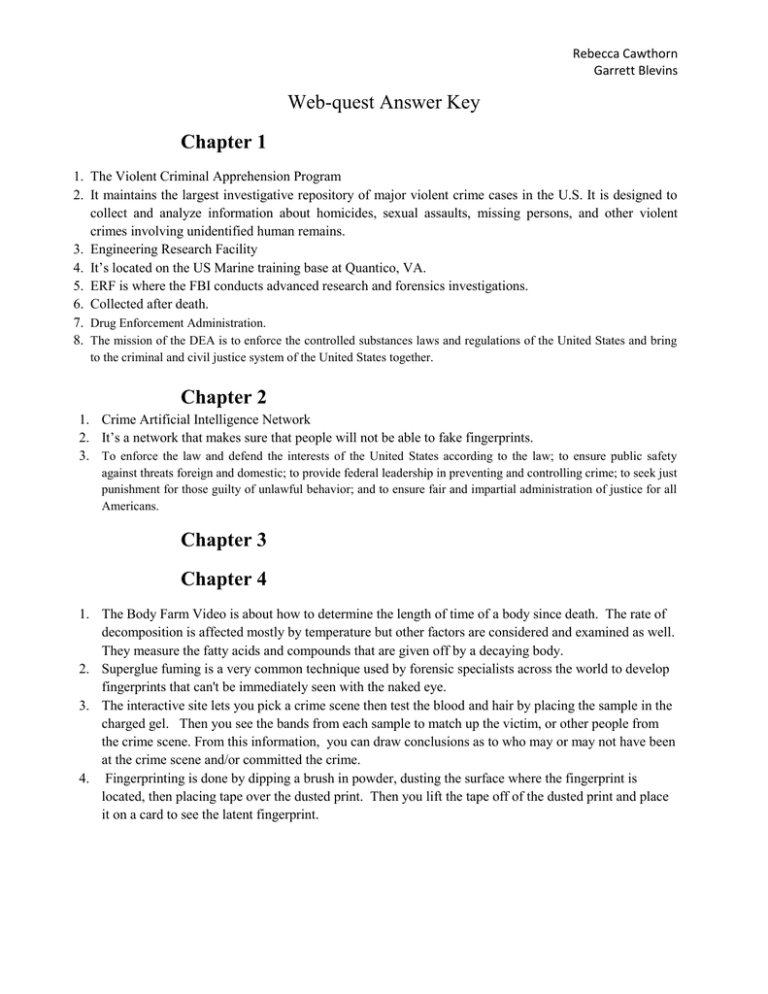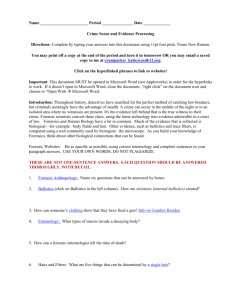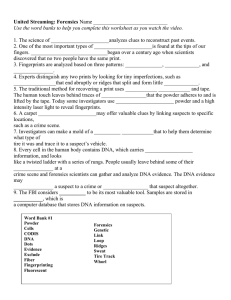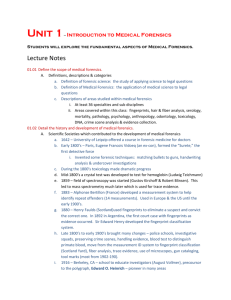Forensic Science Web-Quest Answer Key
advertisement

Rebecca Cawthorn Garrett Blevins Web-quest Answer Key Chapter 1 1. The Violent Criminal Apprehension Program 2. It maintains the largest investigative repository of major violent crime cases in the U.S. It is designed to collect and analyze information about homicides, sexual assaults, missing persons, and other violent crimes involving unidentified human remains. 3. Engineering Research Facility 4. It’s located on the US Marine training base at Quantico, VA. 5. ERF is where the FBI conducts advanced research and forensics investigations. 6. Collected after death. 7. Drug Enforcement Administration. 8. The mission of the DEA is to enforce the controlled substances laws and regulations of the United States and bring to the criminal and civil justice system of the United States together. Chapter 2 1. Crime Artificial Intelligence Network 2. It’s a network that makes sure that people will not be able to fake fingerprints. 3. To enforce the law and defend the interests of the United States according to the law; to ensure public safety against threats foreign and domestic; to provide federal leadership in preventing and controlling crime; to seek just punishment for those guilty of unlawful behavior; and to ensure fair and impartial administration of justice for all Americans. Chapter 3 Chapter 4 1. The Body Farm Video is about how to determine the length of time of a body since death. The rate of decomposition is affected mostly by temperature but other factors are considered and examined as well. They measure the fatty acids and compounds that are given off by a decaying body. 2. Superglue fuming is a very common technique used by forensic specialists across the world to develop fingerprints that can't be immediately seen with the naked eye. 3. The interactive site lets you pick a crime scene then test the blood and hair by placing the sample in the charged gel. Then you see the bands from each sample to match up the victim, or other people from the crime scene. From this information, you can draw conclusions as to who may or may not have been at the crime scene and/or committed the crime. 4. Fingerprinting is done by dipping a brush in powder, dusting the surface where the fingerprint is located, then placing tape over the dusted print. Then you lift the tape off of the dusted print and place it on a card to see the latent fingerprint. Rebecca Cawthorn Garrett Blevins Chapter 5 1. State Bureau of Investigation is a division of the Department of Justice. 2. The SBI investigates homicides, robberies, property crimes, and other serious cases. Chapter 6 1. 2. 3. 4. Scalpel, chest incision Without delay Medical examiner Forensic pathologists are specially trained physicians who examine the bodies of people who died suddenly, unexpectedly, or violently. The forensic pathologist is responsible for determining the cause and manner of death. Chapter 7 Chapter 8 1. to dig (something buried, especially a dead body) out of the earth Chapter 9 part 1 1. Embalming is the art and science of temporarily preserving human remains. 2. Powders (especially baby powder) are applied to the body to eliminate odors, and it is also applied to the face to achieve a matte and fresh effect to prevent oiliness of the corpse. 3. Sudden Infant Death Syndrome 4. 2500 Chapter 9 part 2 1. Funeral Director 2. A professional involved in the business of funeral rites. These tasks often entail the embalming and burial or cremation of the dead, as well as the planning and arrangement of the actual funeral ceremony. Funeral directors may at times be asked to perform tasks such as dressing, casketing, and cosmetizing the body. Chapter 10 1. The classification of human blood based on the inherited properties of red blood cells (erythrocytes) as determined by the presence or absence of the antigens A and B, which are carried on the surface of the red cells. Persons may thus have type A, type B, type O, or type AB blood. Rebecca Cawthorn Garrett Blevins 2. Persons with type AB blood can receive type A, B, or O blood 3. deoxyribonucleic acid, The information in DNA is stored as a code made up of four chemical bases: adenine (A), guanine (G), cytosine (C), and thymine (T). Human DNA consists of about 3 billion bases, and more than 99 percent of those bases are the same in all people. The order, or sequence, of these bases determines the information available for building and maintaining an organism DNA bases pair up with each other, A with T and C with G, to form units called base pairs. Each base is also attached to a sugar molecule and a phosphate molecule. Together, a base, sugar, and phosphate are called a nucleotide. Nucleotides are arranged in two long strands that form a spiral called a double helix. 4. Office of Professional Responsibility, OPR investigates allegations of misconduct involving employees of ICE and U.S. Customs and Border Protection (CBP). OPR oversees ICE detention functions, ensuring that facilities adhere to the agency’s detention standards. In the event of a detainee’s death, OPR investigates the circumstances of that death. Chapter 11 part 1 1. Phencyclidine 2. A moderate amount of PCP often causes users to feel detached, distant, and estranged from their surroundings. Numbness of the extremities, slurred speech, and loss of coordination may be accompanied by a sense of strength and invulnerability. A blank stare, rapid and involuntary eye movements, and an exaggerated gait are among the more observable effects. Auditory hallucinations, image distortion, severe mood disorders, and amnesia may also occur 3. the main metabolite of cocaine 4. Drug Screening Chapter 11 part 2 5. 1932 6. Virginia 7. Combined DNA Index System (CODIS) - Federal DNA Database - Latent Print - Mitochondrial DNA - Nuclear DNA Forensic Response - Chemical, Biological, Radiological, & Nuclear Sciences - Crime Scene Documentation - Evidence Response Team - Hazardous Evidence Response - Operational Projects - Scientific Response - Technical Hazards Response Rebecca Cawthorn Garrett Blevins Chapter 12 1. Dead on arrival Chapter 13 1. Ordinance, Resolution 2. A resolution is a written motion of council which generally establishes a determination or expression of a policy or position on an issue. An ordinance is required by state law for certain actions 3. Blood Alcohol Concentration 4. Factors that determine BAC Number of standard drinks Amount of time in which drinks are consumed Body weight Gender Food (to a much lesser extent) BAC is calculated using these factors and comparing them on a chart. Chapter 14 1. 2. 3. 4. a blow or jolt to the head that can change the way your brain normally works Headache, Weakness, Numbness Decreased coordination or balance, Confusion, Nausea, Slurred Driving under the influence .08% BAC Chapter 15 1. National Organization for Women 2. The identification of human physical and behavioral identification is being done by fingerprints, bone structure, and scolara. 3. Yes 4. Press your finger into putty then fill the indent with gelatin. Rebecca Cawthorn Garrett Blevins Chapter 16 1. By their chemical composition 2. Trace evidence 3. A relatively rare form of child abuse that involves the exaggeration or fabrication of illnesses or symptoms by a primary caretaker. 4. Typically, the cause is a need for attention and sympathy from doctors, nurses, and other professionals. Also, the satisfaction in deceiving individuals who they consider to be more important and powerful than themselves. Chapter 17 Chapter 18 1. A laboratory of human flesh. The purpose for the farm is to be able to study the decay of human flesh. 2. The Body Farm Chapter 19 1. 2. 3. 4. A type of firearm 1 in 3 bullets that have a small pit in their tips which allow them to expand upon impact License plate numbers, fingerprints, lighting, facial features, lettering on signs, foggy photos, blurry photos, depth perspective, camera angles, video movement,. Chapter 20 1. Carotid arteries are located on each side of the neck, just below the jaw line. 2. The artery supplies blood to the brain. Chapter 21






